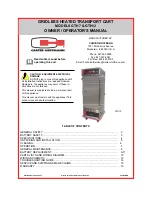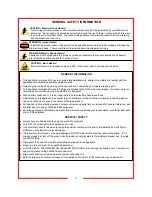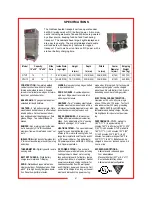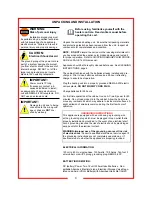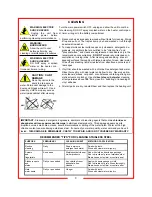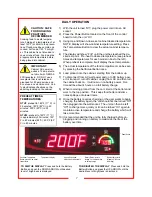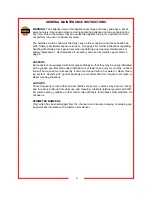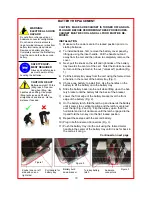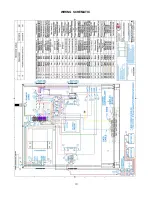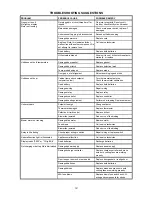
6
CLEANING
Turn the main power switch OFF, unplug and allow the unit to cool be-
fore cleaning. DO NOT spray or splash water on the heater, control pan-
el, timer, wiring or in the battery compartment.
1. Racks or shelves are easily removed without tools for cleaning, Simply
lift up and pull out. The tray racks may be hand washed or run through
an automatic washer.
2. To clean stainless steel surfaces use only cleansers, detergents, de-
greasers, or sanitizers that are certified to be "chloride-free" and
"phosphate-free," and cleansers, degreasers, or sanitizers only in the
recommended concentrations.
DO NOT
exceed recommended con-
centrations or mixing ratios. After cleaning and sanitizing, rinse all
exposed surfaces thoroughly with large amounts of clean, clear water.
Wipe off any standing liquid or residue from all surfaces, corners and
rear edges.
3. Vinyl trim should be washed with a chlorine-free detergent and water.
Rinse thoroughly with clear water and allow to dry. Never use abra-
sive cleaners, waxes, car polish, or substances containing strong aro-
matic solvents or alcohol. Use of
direct steam / hot water
cleaning
at temperatures above
190
°
F
may result in “bubbling” or loosening of
vinyl adhesive.
4. After all parts are dry, reinstall them and then replace the heating unit.
WARNING: ELECTRIC
SHOCK HAZARD
Unplug the unit from
electric
power
before
performing cleaning or maintenance.
WARNING:
BURN HAZARD
Allow the unit to cool
before performing any
cleaning or maintenance procedures.
WARNING: ELECTRIC
SHOCK HAZARD
DO NOT spray or splash
water on the heater, con-
trol panel, timer or wiring.
IMPORTANT:
Cleansers, detergents, degreasers, sanitizers or bleaching agents that contain
chlorides or
phosphates will cause permanent damage
to stainless steel products. This damage appears as pits,
eruptions, voids, small holes, cracks, severe discolorations or dulling of the metal finish. Water with a high
chlorine content can also damage stainless steel. If unsure of your water quality, we recommend you have it
tested
. THIS DAMAGE IS PERMANENT, COSTLY TO REPAIR, AND IS NOT COVERED BY WARRANTY.
PURPOSE
FREQUENCY
CLEANING AGENT
METHOD OF APPLICATION
Routine
cleaning
Daily
Soap, ammonia,
detergent and water
Swab with cloth.
Rinse with clear water, wipe dry.
Smears
and
fingerprints
As needed
Stainless steel cleaner,
similar products
Rub with cloth as directed on package.
Rub in direction of grain of stainless steel.
Do not
use on vinyl trim or control panel.
Stubborn spots
and
stains
Daily or as needed
Any chloride-free or
phosphate-free
cleanser
Apply with damp sponge or cloth.
Rub in direction of grain. Rinse thoroughly.
Do not
use on vinyl trim or control panel.
Hard
water spots
Daily or as needed
Vinegar
Swab with cloth.
Rinse with clear water, wipe dry.
RECOMMENDED "TIPS" FOR CLEANING STAINLESS STEEL
CAUTION: CART
DAMAGE
Do not tip cart onto the
doors to drain excess
water. Permanent damage to the
doors and hinges will result. Use a
clean dry cloth to mop any excess
water inside cabinet after cleaning.
Summary of Contents for GTH12
Page 13: ...WIRING SCHEMATIC 13...

